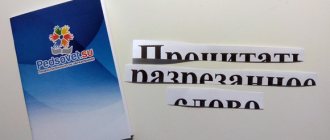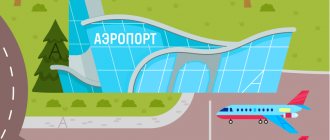At what age should you start learning to read?
There is no consensus on when it is best to start classes - every parent or teacher has their own thoughts on this matter. However, most experts recommend starting to learn to read no earlier than 5 years of age. By this age, the necessary abilities are already formed - the ability to remember, reproduce in memory and recognize various symbols.
But age is far from the only indicator of readiness to learn. Therefore, it is important to make sure that he already has all the necessary abilities.
Letter constructor
- How to teach a 5-year-old child to read so that he doesn’t forget the letters? Buy him a cut-out alphabet or make an Alphabet set yourself. Select the necessary letters and ask them to form a word from them. The rule of the game is to use all the cards. For example: T, K, O - CAT, D, M, S - SMOKE, etc. A little later, when the baby understands this task, complicate the rules. Add an unnecessary letter, increase the length of the word.
- Make a cut alphabet - cut each letter into 2 parts and let your child assemble it!
- Offer your child a piece of soft wire 10-15cm long - it makes interesting letters.
How to understand if a child is ready to start learning
To begin with, you should make sure that the student already has all the necessary skills. First of all, this concerns the level of development of oral speech. A preschooler must be able to express himself clearly and logically, construct sentences correctly, pronounce all sounds, discuss certain topics, and retell any events.
It is also important to consider your level of concentration. Not all children are able to concentrate on a lesson for a long time without being distracted by outside stimuli. If they lack perseverance, then they will not be able to fully comprehend the material proposed by their parents or teacher, which means the effectiveness of the classes will decrease.
Only after making sure that the student is ready can you begin to master literacy, and for this you need to choose the most suitable one from a list of various programs. Let's take a closer look at them.
Techniques for expanding your angle of vision
In the process of reading, the number of characters that fall into the child’s field of vision matters. To expand the angle of peripheral vision, it is recommended to offer children the following exercises.
Schulte tables
Schulte tables contain numbers from 1 to 30, which are arranged in a chaotic order. Students need to find and indicate each number in order in 30 seconds. After a few days, you should offer another version of the table.
- See Schulte Table Generator Online.
Find the word
The essence of this exercise is similar to the previous one. On a piece of paper you need to write several different, not very long words in random order. The task for schoolchildren is to find words on a sheet of paper as quickly as possible, which the teacher will name one by one.
Word pyramids
For such exercises, words are written in a column, starting with the word with the fewest letters. Each word is divided into two parts, which are written at some distance from each other. On each subsequent line this distance increases.
First - last
You can use any text for this exercise. Children only need to read the first and last syllable of each line.
Reading frame
It is necessary to prepare a strip of cardboard with a slot, the height of which is slightly greater than the height of the letters in the textbook. The width should be small, about 3 - 4 letters. While reading, the child moves this frame around the text. After a certain time, the width of the frame should be gradually increased.
Over time, children remember many words that appear frequently in texts and perceive them as a whole. They no longer read such words, but name them right away. This skill significantly saves time when reading, so this skill needs to be purposefully developed.
Methods of teaching preschoolers to read
There are a huge variety of methods for teaching children to read, but the most popular is the phonetic method. It is on this basis that preschoolers learn in kindergarten, and it is on this basis that first-graders are taught literacy in schools. The phonetic (or sound) method involves the sequential study of sounds, and then letters and syllables until the development of phrasal perception of the text. Parents and teachers value this approach for its consistency and the ability to move smoothly from one topic to another.
But along with this method, others are also popular:
- Montessori method. The difference between this method is that children first learn to write letters by tracing them with their finger along special contour guides, and only then study them. The advantages include additional motor development and a playful form that allows you to practice with interest. But there are also disadvantages - a large amount of teaching materials is required. Also, a teacher or parent using this method is not so much teaching as observing the process, which is why efficiency suffers.
- Zaitsev's cubes. For classes, special cubes are used, which depict various letters or their combinations - warehouses. They are different from the usual syllables. If a syllable must necessarily contain a vowel, then the warehouses can consist of either a combination of a vowel and a consonant, or of one consonant or its combination with a sign of hardness/softness. For example, reproducing the words “locomotive” and “swan” in warehouses will look like “pa-ro-vo-z” and “swan-swan”. It is believed that this makes it much easier for kids to learn the basics. But it is worth remembering that at school children will have to perform syllabic analysis and demonstrate syllable reading skills. If they were taught using Zaitsev's cubes, then they will have to relearn.
- Soboleva's technique. It is based on the use of the baby’s imagination, and the program itself takes into account how he better perceives information - visually, kinetically, auditorily. The student masters a particular letter through some image - an image of a recognizable character or object. A playful approach is used, which allows not only to teach a child to read, but also to get him interested in reading. Despite all the advantages of this program, it lacks consistency, but its elements are often used in other training formats.
- Doman cards. This program differs from all those listed - it teaches kids to immediately perceive whole words, skipping other stages. Proponents of this method argue that it can be taught from a very early age. However, if adults teach a child to read using cards, this can cause problems at school age - it will be difficult for students to parse a word, since they have missed the sound, letter and syllable stages.
Start with speech development
Before learning to read, a child must learn to speak. And the correctness of speech development directly depends on their environment. The more intelligent the parents, the more attention they pay to the younger generation, the easier it is for the child to develop.
From the first days you need to work with your baby on speech development
Starting the first communications with adults through hooting, the baby gradually tries to imitate the speech sounds that he hears every day. And if at first these are just individual syllables, then already from the age of 2 years of normal development the child can operate with simple sentences.
Further - more, the baby moves on to word forms. And the more actively the parents communicate with the child, the more talkative he will be (in a good way). The main help in the development of a child’s speech will be reading, i.e. books that adults will read aloud to their children.
Develop your baby's interest in reading
Naturally, a small child cannot read on his own. But you can accustom him to communicate with literature from the first years of his life. It is children's books that form the correct speech development of the baby. The more often a child sees a book in the hands of his parents, the more confidence he develops in it, and the faster over time the desire to learn to read independently appears.
Interest in reading develops in a playful way
Reading should be turned into a kind of ritual - fairy tales, nursery rhymes, lullabies are best perceived before bed. The clearer and more correct the adult’s pronunciation during reading, with emotional connotation, the more memorable the phrases the child will hear will be.
And the clearer the baby’s visual images will appear. And this will further help in learning to read. After all, the better a child thinks in images, the faster and easier he learns.
About the benefits of family reading
To develop children's skill, they should read fairy tales aloud from preschool age. The child must develop not just an interest in literature - the book must become a symbol of psychological “pleasure”.
Family reading develops children's interest in it
And in the future, even magazines and books standing on shelves (and not in the hands of parents) will be associated with positive emotions and attract the child’s attention. In other words, reading books to your child instills a love of literature for life, giving impetus to the fastest learning of independent reading.
In addition, reading to children promotes their spiritual unity with their parents, bringing joy to everyone. And the child develops a feeling of family comfort, which he associates with books. In a family where there is a cult of books, children quickly develop a desire to read.
Read with your children
The best way to prepare your child for independent reading is to read a book while sitting next to your baby. He should see the pages of the book on which the text is written. This will first allow you to visually get used to the letters that involve you in the world of the sacraments.
A child’s first books should be of high quality and bright
It’s not for nothing that the first children’s books are rich in colorful illustrations. With their help, you can perceive what you hear in images drawn in the pictures. And when the child goes to first grade and begins to put letters into words, familiar phrases will already be perceived figuratively, which will make it faster and easier to learn to read.
While reading a fairy tale or nursery rhyme, try to move your child’s finger over the letters so that the baby can see which word you are reading. Visual memory will help with proper learning in the future.
Important stage: reading syllables
Some programs, as well as unsystematic independent studies, do not allow you to work on one of the most significant stages - syllabic. In the future, this leads to the fact that it is difficult for the student to master phrase reproduction. He fails to smoothly transition to it after the syllable stage, since the speed and quality of reading comprehension suffers.
Therefore, after studying the alphabet and mastering letter-by-letter reproduction, it is necessary to study syllables, starting with simple ones and gradually moving to complex ones. This is the approach used in the phonic method, which is why it is best suited for teaching children to read.
Reception "Tug"
The “Tug” technique is used to increase the pace of reading. The leader can be a teacher or a student with a high reading technique. He reads the text, and the rest should try to keep up with him. This exercise can be done for the whole class or in pairs.
To control the reading process of all students, you can make sudden stops and ask the children to show the last word read in the text. Another way is to make mistakes while reading. Those who read “in tow” should notice them and correct them.
Games that teach reading
Even the proven classic method needs to be adapted for preschoolers, and for this it is worth introducing game elements into it. This way, it will be possible to involve students in the lesson process, thanks to which they will be able to study with interest. The following games can be used during classes:
- “name the objects that begin with...” Parents tell the child a letter, and he comes up with as many words as possible that begin with it. This game not only reinforces knowledge of the alphabet, but also trains the imagination and expands vocabulary.
- "Find the hidden letter." A letter is called to the preschooler, and he must quickly find it among the others. By completing this task, he will be able to consolidate the material already studied and increase his reaction speed.
- "find new words." Adults come up with and write down some long word, for example, “education,” and the baby makes up words from its letters: “image,” “time,” “call,” “cart,” and so on.
- “Match it with the picture.” You are asked to read two words and combine one of them with a picture. This task trains imaginative thinking and text reproduction skills, and also teaches you to more consciously perceive what you read.
Whole word method
The method of teaching whole words (also called “global reading”) in our country is often associated with the name of Glen Doman, although this method has been used in Western Europe for centuries, long before Doman. Doman simply proposed teaching children this classical method from the very first days of birth, believing that this lays the foundation for the accelerated intellectual development of the child. Since the eyes of a newborn baby cannot distinguish any colors except red, Doman suggested showing babies words printed in bright red font - this is precisely Doman's innovation. We have to admit that the idea of early intellectual acceleration causes great skepticism among many specialists. As Glen Doman himself admits, until about the age of four, although children are able to visually recognize hundreds of memorized words, they still cannot cope with reading new words.
This concludes our review of the main methods of teaching reading. We hope that this information will be useful to someone. It must also be said that today dozens, even hundreds of proprietary methods have been developed for each of these methods. They all have their own charm, their own advantages and disadvantages. Some authors combined elements and principles of different methods in their methods - sometimes logically, sometimes not. It is, of course, impossible to list and analyze them all within the scope of this article. Parents must decide for themselves which direction they want to choose, or which methods can successfully complement each other. We wish your children useful and successful activities!
Exercises for learning to read
You can use various exercises to train your skills. For example, if the alphabet has already been studied, then you can name a letter and ask to determine whether it is a vowel or a consonant, soft or hard (for consonants), stressed or unstressed (for vowels). In the future, this exercise will help you better cope with sound-letter analysis, which is studied in primary school. The baby will already know the basic characteristics and properties of sounds, which will greatly facilitate the learning process.
Another important exercise is regular text reproduction. The more often a child reads, the more effectively he is able to improve his skills. However, before moving on to this stage, you need to make sure that all the previous ones are well secured and worked out. It is important to study all the necessary topics consistently, and for this you need to study according to a proven methodology.
"Hidden Letters" Technique
Improving reading technique is facilitated by developing the ability to predict words rather than read them letter by letter. To do this, you can offer the following tasks:
- words with blots - a word is written on the card, part of which is covered by a blot;
- words with missing letters - there is a word on the card in which several letters are missing;
- cut word - a card with a written word is cut lengthwise and children are asked to read the word either along the upper or lower part (the word can not be cut into pieces, but cover half of it with a ruler);
- A more difficult version of this exercise is to predict the missing word. For it, you can use catchphrases, phraseological units, famous phrases from fairy tales or poems, riddles with rhyming answers.
Basic methods – which one to choose?
When choosing a program, it is important to pay attention to many criteria - find out what stages it includes, in what form the classes are conducted, whether they will be interesting, whether it will be easy to learn to read. It is worth remembering that the goal of this or that method is not only to teach literacy, but also to interest, to awaken the desire to get acquainted first with small texts, and then with books. To do this, classes must be taught by professional teachers according to a program that takes into account the age characteristics of students.
Preschoolers from 5 years of age and younger schoolchildren will benefit from the reading teaching method from the AMAkids Academy for the Development of Intelligence. Its key feature is the game format, as well as the principle of a gradual transition from simple to complex topics. Before moving on to a new stage, students’ knowledge is checked and, if necessary, further consolidated. This way you can more effectively master all the material and learn to read fluently. Sign up for courses from AMAkids and start teaching your child to read and write now.
When should you start teaching your child to read?
Many parents are worried that their child will not learn to read before school and begin to do this almost from the age of 2. But as I described in my own example, this is all very individual. There is no need to rush - watch the baby.
- At 3-4 years old, most often the baby is not yet ready to learn to read. It is difficult for him to sit in one place for a long time and maintain attention. Therefore, at this time, it is better to enrich his knowledge about the environment, replenish his vocabulary and develop his speech.
- Consider your child's individual characteristics. Don't look up to other children.
- The best time to learn to read is 5 - 6 years old. If your child does not attend preschool or various developmental courses, start doing this yourself. Below we will tell you how.
Reception "Lips"
When speaking externally, reading speed slows down. Therefore, children should also be taught to read silently, without external signs of pronunciation. During reading, when the teacher gives the command “Lips!”, students should begin to read “to themselves.” At the same time, they need to press their finger against their closed lips to prevent them from moving. After the command “Aloud!” the finger should be removed and proceed to reading aloud.
When working to improve reading technique, it is important to take into account that the quantitative indicator depends on the type of temperament of the child and the level of development of his thought processes. Therefore, of course, it will not be possible to “bring up” all students to the required standards, but it will undoubtedly be possible to improve the results of everyone. In addition, in parallel with increasing reading speed, it is imperative to pay attention to the development of expressiveness and awareness of reading, to teach children to read correctly, without errors.
About the author-compiler: Gladko Marina Gennadieva, primary school teacher, work experience about 25 years.









